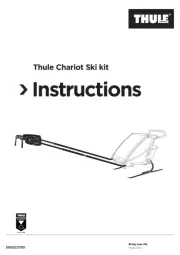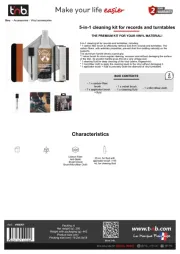Thule Load Stop 502 Handleiding
Thule
Niet gecategoriseerd
Load Stop 502
Bekijk gratis de handleiding van Thule Load Stop 502 (64 pagina’s), behorend tot de categorie Niet gecategoriseerd. Deze gids werd als nuttig beoordeeld door 17 mensen en kreeg gemiddeld 4.8 sterren uit 9 reviews. Heb je een vraag over Thule Load Stop 502 of wil je andere gebruikers van dit product iets vragen? Stel een vraag
Pagina 1/64

EN
DE
FR
NL
IT
ES
PT
SV
DK
NO
FI
2
3
5
7
9
11
13
16
17
19
21
ET
LV
LT
PL
RU
UK
BG
CS
SK
SL
HR/BiH
23
24
26
28
30
32
34
36
38
40
42
RO
HU
EL
TR
HE
AR
ZH
JA
KO
TH
43
45
47
49
51
53
54
55
57
59
Safety
A6.20180619
501-6620-11
Thule roof rack and roof accessories
www.thule.com

2501-6620-11
EN
A.0 Fitting
A.1 Check with the assembly instructions that all the necessary parts are
present.
A.2 Clean the car roof and those parts of the product that come into contact
with the roof before and regularly during use.
A.3 Go through and carefully follow the assembly instructions and the recom-
mendation list, if one is included. Then fit the unit in the correct sequence,
that is to say 1, 2, 3 and so on.
A.4 If no special fitting positions are given in the assembly instructions, try to
maintain a minimum distance of 700 mm between the load carrier bars.
A.5 When carrying long loads, the distance between the load carrier bars
should not be less than 600 mm.
A.6 Every time the unit is fitted, check that the load carrier is sitting securely
on the roof. Try to push and pull the carrier out of its locked position. Try
also to pull out the tensioning tabs from the roof edge. If you manage to
move any part of the unit, the load carrier must be secured more firmly.
This test should be carried out regularly.
A.7 Some types of sunroof and radio antenna cannot be used when the carri-
er is fitted.
A.8 The roof rack is permitted to be assembled on cars with glass roof, unless
otherwise is specified in mounting instruction.
A.9 The manufacturer can not be held responsible for personal damages of
property or lost of fortune caused by incorrect mounting or use of the
product.
A.10 No modifications to the product are permitted.
A.11 Consult with your dealer if you have any questions regarding the oper-
ations and limits of the products. Review all instructions and warranty
information carefully.
B.0 Loading
B.1 The maximum load specified in the assembly instructions is not to be
exceeded. However, this limit is always subordinate to the maximum load
recommended by the manufacturer of the car itself. It is always the lower
maximum recommended load that applies. Max. roof load = load carrier
weight + any fitted carrier accessories + the weight of the load itself.
B.2 The load may not significantly exceed the load carrier’s width, and it
should always be spread evenly across the load carrier and with the
lowest possible centre of gravity.
B.3 Maximum load applies to driving as well as parked vehicle.
B.4 When several surfboards are being carried, they should not be placed
beside each other but instead one on top of the other.
B.5 When carrying surfboards and other long items, these shall be secured
both at the front and the rear of the vehicle.
B.6 Skis must be carried with their pointed ends facing the rear of the vehicle.

3501-6620-11
B.7 All loose or removable parts of the load such as bike child seats, tyre
pumps, fins and so on should be taken off prior to loading.
B.8 The load should be thoroughly secured. Elastic bungees are not to be
used.
B.9 The load’s security should be checked after a short distance, and there-
after at suitable intervals. Tighten the load’s securing straps whenever
necessary.
NOTE! Always check the load’s attachment security.
C.0 Driving properties and regulations
C.1 Road speed should always be adjusted to suit the loadbeing carried
and the current driving condtions, such as road type and quality, wind
conditions, traffic intensity and applicable speed limits.
C.2 The vehicle’s speed must always be adjusted to the load being car-
ried and the current driving conditions, such as the road type, road
quality, wind conditions, traffic intensity and applicable speed limits,
but must under no circumstances exceed 130 km/h. Applicable speed
limits and other traffic regulations must always be observed.
C.3 Drive slowly over speed bumps, maximum speed 10 km/h.
C.4 Note that the vehicle’s total height increases when upright loads are
carried.
C.5 The vehicle’s driving characteristics and braking behaviour change and
its vulnerability to side-winds increases when a load is carried on the
roof.
C.6 Products fitted with a lock should always be locked during transport.
C.7 Off-road driving is only approved for roof rack without load or
accessories attached.
C.8 Adapt your speed to the conditions of the road and load being carried,
check tension of load carrier frequently, especially when travelling on
rough roads.
D.0 Maintenance
D.1 Check and replace worn-out or defective parts.
D.2 The load carrier should always be cleaned and maintained, especially in
the winter.
D.3 Screws, nuts and locks (if fitted) should be lubricated at regular intervals.
D.4 When not in use, the product should be removed from the vehicle.
D.5 When the product is removed from the vehicle, all loose parts should be
stored safely.
DE
A.0 Montage
A.1 Anhand der Montageanweisung kontrollieren, daß alle Teile mitgeliefert
sind.
A.2 Das Fahrzeugdach und die Teile des Produkts, die mit dem Dach in
Berührung kommen, reinigen.
Product specificaties
| Merk: | Thule |
| Categorie: | Niet gecategoriseerd |
| Model: | Load Stop 502 |
Heb je hulp nodig?
Als je hulp nodig hebt met Thule Load Stop 502 stel dan hieronder een vraag en andere gebruikers zullen je antwoorden
Handleiding Niet gecategoriseerd Thule

21 Februari 2025

6 December 2024

6 December 2024

6 December 2024

6 December 2024

15 November 2024

29 Augustus 2023

26 Augustus 2023

25 Juli 2023

24 Juli 2023
Handleiding Niet gecategoriseerd
- Durex
- SEIKI
- Apc
- Swissvoice
- Moen
- AMERRY
- Fitbit
- Cloer
- FABER CASTELL
- Bunn
- Doepfer
- Flover
- Redrock Micro
- OOONO
- Mytee
Nieuwste handleidingen voor Niet gecategoriseerd

13 September 2025

13 September 2025

13 September 2025

13 September 2025

13 September 2025

13 September 2025

13 September 2025

13 September 2025

13 September 2025

13 September 2025